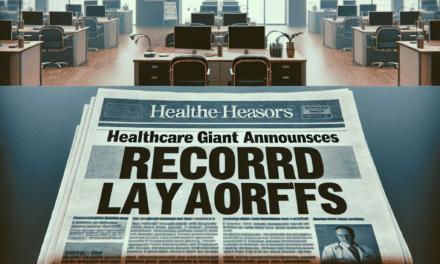CDRH Faces Emotional Farewells Amid HHS Mass Layoffs
The recent mass layoffs at the Department of Health and Human Services (HHS) have sent shockwaves through the healthcare community, particularly affecting the Center for Devices and Radiological Health (CDRH). As the agency responsible for ensuring the safety and effectiveness of medical devices, the CDRH plays a critical role in public health. The emotional toll of these layoffs is profound, impacting not only the employees but also the healthcare system at large. This article delves into the implications of these layoffs, the emotional farewells experienced by employees, and the broader context of workforce changes within HHS.
The Context of HHS Layoffs
The HHS layoffs are part of a larger trend of budget cuts and restructuring within federal agencies. As the government seeks to streamline operations and reduce spending, many departments face difficult decisions regarding workforce reductions. The CDRH, which has been under scrutiny for its regulatory processes and efficiency, is particularly vulnerable in this environment.
In recent years, the CDRH has faced increasing pressure to expedite the approval of medical devices while maintaining rigorous safety standards. This balancing act has led to a growing demand for resources, making the recent layoffs even more concerning. The loss of experienced personnel not only affects the morale of remaining staff but also raises questions about the agency’s ability to fulfill its mission effectively.
- Budget Constraints: The HHS budget has faced significant cuts, leading to a reevaluation of priorities and resources.
- Regulatory Challenges: The CDRH has been criticized for its slow approval processes, prompting calls for reform.
- Workforce Dynamics: The layoffs reflect broader trends in federal employment, where agencies are forced to do more with less.
- Impact on Public Health: The reduction in workforce raises concerns about the safety and efficacy of medical devices.
- Future of CDRH: The long-term implications of these layoffs on the agency’s mission and public trust.
The Emotional Impact on Employees
The emotional toll of layoffs is often underestimated. For employees at the CDRH, the news of impending layoffs was met with shock and disbelief. Many of these individuals have dedicated years, if not decades, to public service, and the prospect of losing their jobs is not just a financial concern but an emotional one as well.
Employees often experience a range of emotions during layoffs, including grief, anger, and anxiety. The sense of loss is palpable, as colleagues who have worked side by side for years face an uncertain future. The emotional farewell process can be particularly challenging in a close-knit environment like the CDRH, where teamwork and collaboration are essential to the agency’s success.
- Grief and Loss: Employees mourn the loss of their colleagues and the work environment they cherished.
- Fear of the Unknown: Uncertainty about future employment and career paths creates anxiety among remaining staff.
- Impact on Morale: The layoffs can lead to decreased morale among remaining employees, affecting productivity and engagement.
- Support Systems: The importance of support networks, both within and outside the workplace, during times of transition.
- Long-term Effects: The potential for lasting emotional scars that can affect future job performance and mental health.
Case Studies: Personal Stories from CDRH Employees
To understand the human side of these layoffs, it is essential to hear from those directly affected. Personal stories from CDRH employees provide insight into the emotional landscape of the agency during this tumultuous time. These narratives highlight the dedication and passion that employees bring to their work, as well as the challenges they face in the wake of layoffs.
One employee, who had been with the CDRH for over 15 years, shared their experience of receiving the layoff notice. “I felt like I had lost a part of my identity,” they said. “This job was not just a paycheck; it was my passion. I dedicated my life to ensuring that medical devices were safe for the public.” This sentiment was echoed by many others who expressed feelings of betrayal and confusion about the agency’s direction.
- Long-term Commitment: Many employees had dedicated their careers to the CDRH, making the layoffs feel like a personal loss.
- Passion for Public Service: Employees often view their work as a calling, adding to the emotional weight of the layoffs.
- Community Impact: Employees expressed concern about how their departure would affect public health and safety.
- Resilience and Adaptation: Stories of employees finding new paths and adapting to change in the face of adversity.
- Support from Colleagues: The importance of camaraderie and support among employees during difficult times.
The Broader Implications for Public Health
The layoffs at the CDRH have significant implications for public health and safety. As the agency responsible for regulating medical devices, the loss of experienced personnel raises concerns about the thoroughness of reviews and approvals. This could potentially lead to delays in bringing innovative medical technologies to market, impacting patient care and outcomes.
Moreover, the CDRH’s ability to respond to emerging public health threats may be compromised. For instance, during the COVID-19 pandemic, the agency played a crucial role in expediting the approval of diagnostic tests and vaccines. With a reduced workforce, the CDRH may struggle to maintain this level of responsiveness in future public health emergencies.
- Regulatory Delays: Fewer staff may lead to longer approval times for critical medical devices.
- Innovation Stifled: The loss of expertise could hinder the development of new technologies that improve patient care.
- Public Trust Erosion: Layoffs may lead to a perception of instability within the agency, affecting public confidence.
- Emergency Response Challenges: The ability to respond to health crises may be compromised due to reduced staffing.
- Long-term Health Outcomes: Delays in device approvals could have lasting effects on patient health and safety.
Looking Ahead: The Future of CDRH and HHS
As the dust settles from the layoffs, the future of the CDRH and HHS remains uncertain. The agency must navigate the challenges of a reduced workforce while continuing to fulfill its mission of protecting public health. This will require innovative solutions and a commitment to maintaining high standards of safety and efficacy in medical device regulation.
One potential avenue for the CDRH is to leverage technology to streamline processes and improve efficiency. By adopting advanced data analytics and artificial intelligence, the agency could enhance its ability to review applications and monitor post-market performance. Additionally, fostering partnerships with industry stakeholders may help bridge the gap left by the loss of experienced personnel.
- Embracing Technology: The potential for digital tools to improve regulatory processes and efficiency.
- Collaboration with Industry: Building partnerships to share knowledge and resources in the face of workforce reductions.
- Focus on Employee Well-being: Prioritizing mental health support for remaining staff to maintain morale and productivity.
- Advocacy for Funding: The need for continued advocacy for adequate funding to support the agency’s mission.
- Long-term Vision: Developing a strategic plan to navigate future challenges and ensure the agency’s effectiveness.
Conclusion
The mass layoffs at the CDRH represent a significant turning point for the agency and the healthcare system as a whole. The emotional farewells experienced by employees underscore the human impact of these decisions, highlighting the dedication and passion that drive public service. As the CDRH faces the challenges of a reduced workforce, it must find innovative solutions to continue fulfilling its critical mission of ensuring the safety and effectiveness of medical devices.
Ultimately, the future of the CDRH will depend on its ability to adapt to changing circumstances while maintaining a commitment to public health. By embracing technology, fostering collaboration, and prioritizing employee well-being, the agency can navigate this difficult period and emerge stronger. The lessons learned from this experience will be invaluable as the CDRH and HHS move forward in an ever-evolving healthcare landscape.





